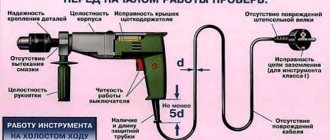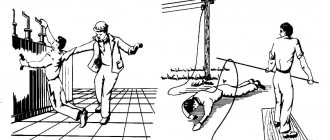Electrical Hazards
A person at a distance cannot detect electrical voltage with his senses. There are three types of effects on the human body:
- thermal - burns, heating of parts of the body;
- chemical - decomposition of blood, lymph with a change in their properties;
- biological - muscles and tissues contract, even to the point of convulsions.
Protective means
Important! By affecting the muscles of the heart and lungs, electric current can disrupt the functioning of the respiratory organs and circulatory system, and lead to cardiac arrest.
Two types of damage:
- Electrical injuries expressed as damage to parts of the body - burns, damage to the iris of the eyes, metallization of the skin.
- Electric shocks are a general damage to the body.
Providing assistance in case of electric shock
The consequences of electric shock are determined by the magnitude of the current and voltage, the time of exposure and the individual characteristics of the person.
General Safety Precautions
To work safely at electrical installations, it is necessary to perform a number of measures that relate to collective protective equipment:
- Have trained, trained personnel who have passed a knowledge test.
- Appoint responsible persons, approve the procedure for performing work, develop instructions (officials, labor protection).
- Accurately carry out organizational and technical measures when carrying out work - drawing up work permits and orders, supervising work, carrying out shutdowns, using posters and fences.
- Application of technical methods and methods (grounding, network separation, shielding devices).
- The design of electrical appliances must have protective mechanisms.
Protection class against electric shock from electrical equipment
Note! Basic documents defining measures of protection against electric shock:
- Rules for electrical installations;
- GOST IEC 61140-2012.
According to these documents, the basic rule of protection is that dangerous live parts must be inaccessible, and accessible parts cannot be under dangerous voltage. The PUE distinguishes between direct touch, when contacting live parts, and indirect touch, when contacting equipment that is energized due to insulation damage.
Measures for protection during normal operation:
- Fences, barriers;
- Basic insulation;
- Locks are used that do not make it possible to turn on the device or remove the fence;
- Application of low voltage;
- Use of alarms (light and sound), warning posters and inscriptions;
- Devices are used to reduce the strength of electromagnetic fields.
To protect people when touching parts of electrical appliances that may be energized if the insulation is damaged, active and passive protection measures have been developed. Examples of active protection:
- automatic power off, switches open the circuit during short circuit currents;
- residual current device (RCD) in devices up to 1000 V.
Electrical safety. Methods of protection against electric shock
To ensure electrical safety during installation and operation of electrical installations, various methods and means of protection are used, the choice of which depends on a number of factors, including the method of power supply.
To ensure protection against electric shock in electrical installations, technical methods and means of protection must be used.
The choice of a particular method or means of protection (or combinations thereof) in a particular electrical installation and the effectiveness of its application depend on a number of factors, including:
- rated voltage;
- type, shape and frequency of electrical installation current;
- method of power supply (from a stationary network, from an autonomous power supply);
- neutral mode of a three-phase current source (midpoint of a direct current source) - isolated neutral, grounded neutral;
- type of execution (stationary, mobile, portable);
- environmental conditions;
- diagrams of the possible inclusion of a person in the current flow circuit (direct single-phase, direct two-phase touch; switching on step voltage);
- type of work (installation, adjustment, testing), etc.
In addition, according to the principle of operation , all technical methods of protection are divided into:
- reducing touch and step voltages to acceptable values;
- limiting the time of exposure to current on a person;
- preventing direct contact with live parts.
The classification of technical methods and means of protection against electric shock in electrical installations is shown in the figure.
The main technical means of protection are:
- Protective grounding;
- Automatic power off (zeroing);
- Residual current devices.
Protective grounding
Grounding reduces to a safe value the voltage relative to the ground of the metal parts of the electrical installation that are exposed to voltage when the insulation is damaged. Protective grounding is an intentional electrical connection to the ground or its equivalent of non-current-carrying parts of an electrical installation that may be energized due to a short circuit to the housing and for other reasons (inductive influence of adjacent live parts, potential removal, lightning discharge, etc.). The equivalent of earth can be river or sea water, coal in a quarry, etc. The electrical resistance of such a connection should be minimal (no more than 4 Ohms for networks with voltages up to 1000 V and no more than 10 Ohms for the rest). In this case, the body of the electrical installation and the personnel serving it will be under equal, close to zero, potentials even in the event of an insulation breakdown and a phase short circuit to the body.
The purpose of protective grounding is to eliminate the danger of electric shock in the event of touching the electrical installation housing and other non-current-carrying metal parts that are energized due to a short circuit to the housing and for other reasons. There are two types of grounding: remote and loop.
Remote grounding is characterized by the fact that its ground electrode (an element of the grounding device in direct contact with the ground) is moved outside the site on which the equipment is installed. This method is used to ground equipment in mechanical and assembly shops. Remote grounding is also called concentrated grounding. A significant disadvantage of remote grounding is the distance of the ground electrode from the equipment being protected, therefore grounding devices of this type are used only for low ground fault currents, in particular in installations up to 1 kV, where the potential of the ground electrode does not exceed the value of the permissible touch voltage. The advantage of remote grounding is the ability to choose the location of the grounding electrodes with the lowest soil resistance (damp, clayey, in lowlands, etc.). The need for a remote grounding device may arise in the following cases:
- if for some reason it is impossible to place a ground electrode in the protected area;
- with high earth resistance in a given area (for example, sandy or rocky soil) and the presence of places outside this area with significantly better earth conductivity;
- with a dispersed location of grounded equipment (for example, in mine workings), etc.
Loop grounding consists of several connected grounding conductors located along the contour (perimeter) of the site on which the grounded equipment is located, as well as inside this site. This type of grounding is used in installations above 1 kV. Loop grounding is also called distributed. The operating principle of protective grounding is to reduce touch and step voltages to safe values due to a short circuit to the body and other reasons. This is achieved by reducing the potential of the grounded equipment (by reducing the resistance of the ground electrode), as well as by equalizing the potentials of the base on which the person stands and the grounded equipment (by raising the potential of the base on which the person stands to a value close to the potential of the grounded equipment).
In alternating current networks with a grounded neutral voltage up to 1 kV, protective grounding is not used as the main protection against electric shock during indirect contact , because it's not effective.
Scope of protective grounding:
- electrical installations with voltage up to 1 kV in three-phase three-wire AC networks with an insulated neutral (IT system);
- electrical installations with voltage up to 1 kV in single-phase two-wire AC networks isolated from the ground;
- electrical installations with voltage up to 1 kV in two-wire DC networks with an isolated midpoint of the current source windings (IT system);
- electrical installations in networks with voltages above 1 kV AC and DC with any mode of neutral or midpoint of the windings of current sources.
Grounding of electrical appliances. Metal housings of electrical installations and appliances (washing machines, electric water heaters, air conditioners, etc.) must be grounded by connecting to the neutral wire of the electrical network. The use of metal pipes and other parts of the water supply, heating or sewer networks for grounding (grounding) is prohibited.
Zeroing
Grounding is a deliberate electrical connection with a solidly grounded neutral of a transformer in three-phase networks of metal non-current-carrying parts that may be energized. In single-phase current networks, parts of the electrical installation are connected to a solidly grounded terminal of the current source, and in direct current networks - to a grounded point of the source. When grounded, the neutral is grounded at the power source. This system is the most widespread. It is considered the main means of ensuring electrical safety in three-phase networks with a grounded neutral with voltages up to 1000 V.
In a network with grounding, it is necessary to distinguish between neutral protective and working conductors. A neutral protective conductor is used to connect the open conductive parts of the electricity consumer to the solidly grounded neutral point of the source. A neutral protective conductor is a conductor that connects the grounded parts of consumers (receivers) of electrical energy with the grounded neutral of the current source. The neutral working conductor is used to supply current to electrical receivers and is also connected to a grounded neutral, but through a fuse. It is impossible to use the neutral working wire as a neutral protective wire, since if the fuse blows, all the housings connected to it may be under phase voltage! Grounding is necessary to provide protection against electric shock due to indirect contact by reducing the housing voltage relative to the ground and quickly disconnecting the electrical installation from the network.
Field of application of zeroing:
- electrical installations with voltage up to 1 kV in three-phase AC networks with a grounded neutral (TN - S system; usually these are networks 220/127, 380/220, 660/380 V);
- electrical installations with voltage up to 1 kV in single-phase AC networks with a grounded terminal;
- electrical installations with voltage up to 1 kV in DC networks with a grounded midpoint of the source.
The operating principle of zeroing. When a phase wire is short-circuited to a grounded housing of an electrical consumer, a single-phase short circuit current circuit is formed (that is, a short circuit between the phase and neutral protective conductors). The current of a single-phase short circuit causes the overcurrent protection to trip, resulting in the disconnection of the damaged electrical installation from the supply network. In addition, before the maximum current protection is triggered, the voltage of the damaged housing relative to the ground decreases, which is associated with the protective effect of re-grounding the neutral protective conductor and the redistribution of voltages in the network when a short circuit current flows. Consequently, grounding provides protection against electric shock in the event of a short circuit to the body by limiting the time the current passes through the human body and by reducing the touch voltage.
The reliability of grounding is determined mainly by the reliability of the neutral protective conductor. In this regard, careful laying of the neutral protective conductor is required to eliminate the possibility of its breakage. In addition, it is prohibited to install switches, fuses and other devices that could damage its integrity in the neutral protective conductor. When connecting neutral protective conductors to each other, reliable contact must be ensured. The connection of neutral protective conductors to parts of electrical installations that are subject to grounding is carried out by welding or bolted connection, and the resistance value between the grounding bolt and each touchable metal non-current-carrying part of the electrical installation, which may be energized, should not exceed 0.1 Ohm. The connection must be accessible for inspection. Neutral protective conductors and openly laid neutral protective conductors must have a distinctive color: yellow stripes on a green background. During the operation of the grounding, the resistance of the phase-zero loop may change, therefore, it is necessary to periodically monitor the value of this resistance. Measurements of the resistance of the phase-zero loop are carried out both after completion of installation work, that is, during acceptance tests, and during operation within the time limits established in the regulatory technical documentation, as well as during major repairs and reconstruction of the network.
of calculating the grounding is to determine the conditions under which it reliably performs its assigned tasks - quickly disconnects the damaged installation from the network and at the same time ensures the safety of a person touching the grounded body during an emergency.
Safety shutdown
Protective shutdown is the automatic shutdown of electrical installations in the event of a single-phase contact with parts energized that are unacceptable for humans, and (or) when a leakage current (short circuit) occurs in the electrical installation that exceeds the specified values.
The purpose of protective shutdown is to ensure electrical safety, which is achieved by limiting the time a person is exposed to dangerous current. Protection is carried out by a special residual current device (RCD), which ensures electrical safety when a person touches live parts of the equipment, allows for constant monitoring of insulation, and turns off the installation when live parts are shorted to ground. To protect people from electric shock, RCDs with an operating current of no more than 30 mA are used.
Scope of application of protective shutdown: electrical installations in networks with any voltage and any neutral mode. Protective shutdown is most widespread in electrical installations used in networks with voltages up to 1 kV with a grounded or insulated neutral.
The principle of operation of an RCD is that it constantly monitors the input signal and compares it with a given value. If the input signal exceeds this value, the device disconnects the protected electrical installation from the network. As input signals of residual current devices, various parameters of electrical networks are used, which carry information about the conditions of electric shock to a person. The RCD reacts to “leakage current” and turns off the electricity within hundredths of a second, protecting a person from electric shock; it detects the slightest current leakage and opens the contacts. Structurally, RCDs are of two types:
- electronic , dependent on supply voltage, their mechanism to perform the shutdown operation requires energy received either from a controlled network or from an external source;
- electromechanical , independent of supply voltage, they are more expensive than electronic RCDs, but have greater sensitivity. The source of energy necessary for the operation of such RCDs is the input signal itself - the differential current to which it reacts.
All RCDs are classified into several types based on the type of input signal:
- responsive to body voltage relative to ground;
- responding to differential (residual) current;
- responsive to a combined input signal;
- responsive to ground fault current;
- responsive to operating current (direct; alternating 50 Hz);
- responsive to zero sequence voltage.
The use of RCDs must be carried out in accordance with the Electrical Installation Rules (PUE).
Passive protection methods
Technical passive protection:
- Reliable conductor insulation (double or reinforced). Its thickness and material are calculated for specific conditions; the insulation must have an allowable resistance of at least 0.5 MOhm with one layer, with two layers 5 MOhm.
- Protective grounding is the connection of metal housings of equipment with a grounding element. The ground loop is in the ground.
- Reduce the supply voltage to a safe level (42 V).
- Use of protective equipment.
First aid for electric shock
Additional Information. All requirements for electrical protective insulating means are set out in the “Instructions for the use and testing of protective equipment used in electrical installations” dated 2003.
Funds are divided into basic and additional. The essence of the difference is that the main ones can withstand operating voltage, while the additional ones do not and are used only to enhance the insulating properties of the main ones. Depending on the voltage class of the installation, the means used.
Basic electrical protective equipment
When working with electrical equipment up to 1 kV, gloves made of dielectric material are used; they will be additional in devices over 1000 Volts. Extension ladders, fiberglass stepladders, dielectric carpets, insulating linings, caps and stands are included in the list of additional ones for both voltage classes.
Important! For each item, the order and frequency of mechanical and electrical tests are established. They must be inspected before each use to ensure they are not dirty or damaged. For example, gloves are twisted towards the fingers and made sure they are tight. Tested products are stamped with a stamp indicating the date of the next test.
Protection against electric current
To ensure electrical safety, it is necessary to strictly follow the rules for the technical operation of electrical installations and take measures to protect against electrical injuries.
Measures and methods for ensuring electrical safety are:
- use of safe voltage;
- control of electrical wire insulation;
- avoiding accidental contact with live parts;
- protective grounding and grounding device;
- use of personal protective equipment;
- compliance with organizational measures to ensure electrical safety.
One aspect may be the use of safe voltage - 12 and 36 V. To obtain it, step-down transformers are used, which are connected to a standard network with a voltage of 220 or 380 V.
To protect against accidental human contact with live parts of electrical installations, fencing in the form of portable shields, walls, and screens is used.
Protective grounding is a deliberate electrical connection to the ground or its equivalent (metal structure of buildings, etc.) of metal non-current-carrying parts that may be energized. The purpose of protective grounding is to eliminate the risk of electric shock to a person if he touches the metal casing of electrical equipment, which, as a result of an insulation failure, is energized.
Grounding is a deliberate electrical connection with a neutral protective conductor of metal non-current-carrying parts that may be energized. The neutral protective conductor is a conductor connecting the grounded parts to the solidly grounded neutral point of the current source winding or its equivalent.
Residual shutdown is a protection system that ensures safety by quickly automatically shutting down an electrical installation when there is a danger of electric shock. The duration of the protective shutdown is 0.1–0.2 s. This method of protection is used as the only protection or in combination with protective grounding and grounding.
Application of low voltages. Low voltages include voltages up to 42V; they are used when working with portable power tools and using portable lamps.
Insulation monitoring . Wire insulation loses its dielectric properties over time. Therefore, it is necessary to periodically monitor the insulation resistance of wires in order to ensure their electrical safety.
Personal protective equipment is divided into insulating, auxiliary, and fencing. Insulating protective equipment provides electrical isolation from live parts and earth. They are divided into basic and additional. The main insulating means in electrical installations up to 1000 V include dielectric gloves and tools with insulated handles. Additional equipment includes dielectric galoshes, mats, dielectric stands.
15 Ultraviolet radiation
Like light, which is visible, ultraviolet radiation (UVR) is a form of optical radiation with a shorter wavelength and higher energy photons (radiation particles) than its visible light counterpart. Most light sources also emit some ultraviolet radiation. UVR is present in sunlight and is also emitted by a large number of ultraviolet sources used in industry, science and medicine. Workers may encounter UVR in a wide variety of occupations. In some cases, in low light levels (ambient light), very strong near-ultraviolet sources (called "black light") may be visible. But usually, UVR is invisible and must be detected by the glow of materials that fluoresce when illuminated by their UVR.
Ultraviolet radiation sources
Sunlight The greatest occupational exposure to UVR comes from outdoor workers exposed to sunlight. The sun's radiation energy is significantly attenuated by the Earth's ozone layer, which limits terrestrial ultraviolet radiation to wavelengths greater than 290-295 nm. Artificial Sources The most significant artificial sources of ultraviolet radiation that affect people are:
Industrial welding arc.
The most important source of potential UVR exposure is radiant energy from arc welding equipment. Levels of ultraviolet radiation around arc welding equipment are very high and can cause acute eye and skin damage after three to ten minutes of exposure when the observer is at close range of several meters. When welding, eye and skin protection is required.
Industrial/work UVR lamps.
Many industrial and commercial processes, such as the photochemical curing of inks, paints and plastics, involve the use of lamps that emit high-intensity ultraviolet radiation. Although the likelihood of harmful effects in humans is low due to the use of shielding, accidental exposure may occur in some cases.
"Black light".
Black light is a name given to special lamps that emit energy primarily in the ultraviolet range. They are commonly used as a destructive testing method for fluorescent powders, to determine the authenticity of banknotes and documents, and for special effects in advertising and discos. These lamps, when affecting a person, do not cause significant harm to him (except in cases of photosensitized skin).
Medical treatment.
Ultraviolet lamps are used in medicine for a variety of diagnostic and therapeutic purposes. UVA sources are commonly used in diagnostic programs. UVA exposure to a patient varies significantly depending on the type of treatment. Ultraviolet lamps used in dermatology should be used with great care by personnel.
Germicidal UVR lamps.
Ultraviolet radiation with a wavelength in the range of 250-265 nm is the most effective for sterilization and disinfection, since this wavelength corresponds to the maximum of the RNA absorption spectrum.
Low pressure mercury outlet tubes are also often used as an ultraviolet source since more than 90% of the energy they emit is at 254 nm. These lamps are often called "germicidal lamps", "germicidal lamps" or simply "ultraviolet lamps". Germicidal lamps are used in hospitals to combat tuberculosis infection, and in microbiological safety rooms to inactivate airborne and surface microorganisms. It is important to install the lamp correctly and use eye protection. Cosmetic tanning.
Tanning beds are located in establishments where clients can tan under special tanning lamps that emit predominantly UVA rays, but also emit a small amount of UVB rays. Regular use of a tanning bed can have a significant impact on a person's annual skin exposure to ultraviolet radiation. Moreover, personnel working in tanning salons may also be exposed to low-level ultraviolet radiation. The use of eye protection such as safety glasses or sunglasses should be mandatory for customers. Depending on the type of tanning salon, tanning salon personnel may also need eye protection.
General lighting.
Fluorescent lights are common in workplaces and homes. These lamps emit small amounts of ultraviolet radiation and contribute only a few percent of a person's annual exposure to this range of radiation. Tungsten halogen lamps are often used more in the home and workplace for a variety of lighting and display purposes. Unshielded halogen lamps can emit UVR at levels sufficient to cause acute injury at close range. Equipping such lamps with glass filters placed over them should eliminate this danger.
Biological effects
Leather
Erythema
Erythema, or “sunburn,” is redness of the skin, usually appearing four to eight hours after exposure to ultraviolet radiation and gradually fading after several days. A severe sunburn may cause the skin to blister and peel.
Photosensitivity
Occupational health professionals are frequently confronted with adverse effects resulting from occupational UV exposure in photosensitized workers. The use of certain medications may have a photosensitizing effect on UVA exposure, as can the topical application of certain products, including some perfumes, body lotions, etc. Reactions to photosensitizing agents can include both photoallergy (an allergic skin reaction) and a condition caused by excess ultraviolet radiation following exposure to ultraviolet light from sunlight or industrial sources (phototoxicosis). (Photosensitivity reactions during use of tanning equipment are also common.)
Late effects
Chronic exposure to sunlight, especially its ultraviolet component, accelerates skin aging and increases the risk of developing skin cancer. Several epidemiological studies have shown that the incidence of skin cancer has a high correlation with latitude, longitude and atmospheric composition in the sky, which are related to the degree of exposure to ultraviolet radiation Accurate A quantitative dose-response relationship for human skin carcinogenesis has not yet been established, although fair-skinned people, especially those of Celtic descent, are much more susceptible to skin cancer.
However, it should be noted that the UV exposure required to produce skin tumors in animal models may occur so slowly that erythema does not occur. Eye
Photokeratitis and photoconjunctivitis
These are acute inflammatory reactions that occur as a result of exposure to UVB and UVC radiation and manifest themselves within several hours of excess exposure. Usually, they pass within one to two days.
Retinal damage from bright light
Although thermal damage to the retina from light sources is unlikely, photochemical damage may occur as a result of exposure to blue-rich light sources. It can result in temporary or permanent loss of vision. However, the normal response of aversion to bright light should prevent such damage from occurring unless a conscious effort is made to focus the gaze on the source of the bright light. The contribution of ultraviolet radiation to retinal damage is generally very small because light absorption by the lens limits retinal exposure.
Chronic effects
Long-term occupational exposure to UVR over decades may contribute to the occurrence of cataracts and non-eye degenerative effects such as skin aging and sun-related skin cancer.
Chronic exposure to infrared radiation may also increase the risk of cataracts, but with eye protection this is unlikely. Safety Standards Occupational exposure limits (ELs) have been developed for ultraviolet radiation, which include an exposure spectrum curve that envelops the threshold data that characterizes the highest results obtained in studies of minimal erythema and keratoconjunctivitis.
When measurement errors and variations in individual responses are taken into account, this curve differs only slightly from the aggregate threshold data and lies exactly below the cataractogenic threshold data for UVB. Occupational Protection Occupational exposure to UVR should be minimized where practical. When using artificial sources, where possible, priority should be given to engineering measures such as filtration, screening and screening. Administrative controls, such as access restrictions, can reduce personal protection requirements.
Outdoor workers, such as agricultural workers, laborers, construction workers, fishermen, etc., can minimize their risk of exposure to ultraviolet rays from the sun by wearing suitable, tightly knit clothing and, more importantly, a brimmed hat to reduce exposure to the face and neck. Sunscreens (eg, creams) may be applied to exposed skin to reduce subsequent exposure. Outdoor workers should have access to shade and be provided with all the necessary protective equipment mentioned above.
There are many industrial sources that can cause acute eye damage within a short exposure time. To avoid this, a variety of eye protection products are used with a degree of protection appropriate to the purpose of its use. Protective equipment intended for industrial use includes welding helmets (providing additional protection from intense visible and infrared radiation and face protection), face shields, safety glasses and UV-absorbing glasses. In general, eye protection used in industry should fit tightly to the face, thereby ensuring that there are no gaps through which ultraviolet radiation can penetrate directly into the eye. Protective equipment must also be properly designed to prevent physical injury.
The appropriateness and choice of eye protection depends on the following factors:
· Characteristics of the intensity and spectral emission of the ultraviolet source. · Behavior patterns of people near UVR sources (distance and exposure time are important). · Conductivity properties (transfer properties) of the material from which protective equipment is made. · Frame designs to prevent peripheral exposure of the eye to direct, unabsorbed ultraviolet radiation.
16 Static electricity
Static electricity
- a phenomenon associated with the accumulation of electrical charges on the surface of a body or in the volume of a substance and characterized by the presence of electric and absence of magnetic fields.
The generally accepted theory of the biological action of S. e. does not exist. Most researchers believe that the basis of the influence of S. e. lies the neuroreflex mechanism. Action of S. e. is expressed in direct irritation of the sensitive nerve endings of the skin, or irritation occurs secondary, due to the polarization of cellular elements and changes in ionic relationships in tissues. Irritation of sensitive nerve endings causes a reaction of the whole organism: skin sensitivity changes, capillary blood flow is stimulated, vascular tone changes, a number of systemic changes are observed, including changes in the central nervous system.
People exposed to prolonged exposure to S. e. complain of increased fatigue, irritability, poor sleep, etc. Objectively, there is a tendency to arterial hypertension and bradycardia, which indicates vascular spasm and dystonia. Action of S. e. not specific and does not cause a specific disease.
Treatment of emerging changes is symptomatic. To prevent the adverse effects of S. e. The following methods of protection are mainly used: prevention of the occurrence of charges. or reducing their generation; removing charges from electrified materials; limiting the time a person spends under the influence of S. e. The first two methods are implemented using technical means - antistatic drugs, neutralizers, shielding devices, antistatic shoes, gloves, gowns, etc.
17 COMBUSTIBLE SUBSTANCES (MATERIALS) – substances (materials) capable of interacting with an oxidizing agent (oxygen
air) in
combustion mode.
Based on flammability, substances (materials) are divided into three groups:
- non-flammable substances
and
materials
that are not capable of spontaneous combustion in air; - low-flammability substances and materials - capable of burning in air when exposed to additional energy from an ignition source,
but not capable of burning independently after its removal; - flammable substances and materials – capable of burning independently after ignition
or
spontaneous combustion.
Combustible substances (materials) is a conditional concept, since in modes other than the standard method, non-flammable and slow-burning substances and materials often become flammable.
Among flammable substances there are substances (materials) in various states of aggregation: gases, vapors, liquids, solids (materials), aerosols. Almost all organic chemicals are flammable. Among inorganic chemicals there are also flammable substances (hydrogen, ammonia, hydrides, sulfides, azides, phosphides, ammonia of various elements).
Combustible substances (materials) are characterized by fire hazard indicators.
By introducing various additives (promoters,
fire retardants, inhibitors
fire hazard indicators can be changed in one direction or another
Individual protection means
Vibration protection means, methods and measures
To prevent personnel from being injured, personal protective equipment is used to protect against electric shock. These include devices that protect the head, eyes, respiratory organs, hands:
- safety helmets;
- glasses, shields;
- gas masks, respirators;
- mittens.
Also required for personal use:
- safety belts and safety ropes protecting against falls from a height;
- special clothing that protects against electric arcs.
Individual protection means
Electricians must use specialized tools with an insulating coating. Hand-held power tools should be periodically checked for insulation integrity. Measuring instruments (voltmeters, ammeters) must be verified.
Classification of protective equipment
WITH
means of protection against electric shock are divided into the following main categories:
- protective products for collective use;
- individual means to protect a working person from high voltage;
- technical devices that ensure safe operation of equipment.
The first category includes indirect means of protection: protective shields and barriers, warning posters and special signs. They allow you to protect the operator during work, both organizationally and technically.
Personal protective equipment
Personal protective equipment against electric current includes the following items:
- protective insulating clothing;
- special shoes and glasses;
- rubber gloves and mats;
- rubberized pads for working tools.
To carry out work on electrical networks, a special tool with insulated handles that protect from touch voltage is used.
In accordance with the provisions of the Intersectoral Rules, permission to work is permitted only with personal protective equipment. According to the importance of the means used, they are divided into main and auxiliary devices and tools. The first group includes dielectric gloves, power tools with insulated handles and measuring clamps. The second group (additional) is represented by such items as dielectric overshoes and carpets, as well as insulating stands and pads.
In industrial settings
In production, to protect personnel from traumatic effects, special measures are used:
- simplicity and clarity of diagrams;
- equipment markings, inscriptions, colors;
- availability of first aid equipment;
- isolation transformers in which the windings must be separated;
- protective electrical separation;
- isolating rooms, platforms.
Note! For protective grounding, both natural grounding conductors are used - building structures in contact with the ground, pipelines, cable sheaths, rail tracks, and artificial ones.
Recommendations for selection
When choosing funds, the following recommendations:
- In installations up to 1 kV, galoshes are used; above 1000 V, boots are used.
- Latex gloves will protect against electric current at voltages less than 1 kV.
- To protect against static electricity, special suits made of fabric with carbon threads are worn.
- For welders, clothing is made of tarpaulin with fire-resistant impregnation, and shoes with fire-resistant soles.
- When choosing kits that protect against electric arcs, the availability of certificates, GOST markings, operating instructions, and test reports.
- In closed switchgears, use insulating gas masks to protect against gases formed during the combustion of electrical insulating materials.
- Gloves are selected only with the markings Ev and En.
General storage rules
When storing protective equipment, you must ensure that they are in good condition and suitability.
Storage of funds
The following rules are followed:
- Stored indoors.
- Store items made of rubber and polymers in cabinets, on racks, and protect them from sunlight, heat, alkalis, and oils.
- Pincers, rods, voltage indicators should not sag or touch the walls during storage.
- Keep gas masks and respirators in special bags.
- They are placed in specially equipped places, preferably at the entrance to the room, on control panels, and must be equipped with hooks, shelves, and brackets.
Since we learned to use electric current, many methods and methods have been invented to protect against its dangerous effects. Existing protective equipment must be known and used correctly, this is the key to effectiveness and safety.
Procedure for storing protective equipment
The effectiveness of electrical protective equipment depends on many factors, including compliance with the rules for their storage. In this case, the following mandatory requirements must be met:
- it is necessary to store protective equipment indoors, in conditions that ensure their serviceability and suitability for use;
- protective equipment made of rubber and polymeric materials are stored in cabinets or on racks separately from the tools and be protected from the effects of acids, alkalis, oils, etc., as well as from exposure to sunlight and thermal radiation from heating devices;
- protective equipment is placed in specially equipped places at the entrance to the premises, on control panels.
It should also be noted that protective equipment can only be stored in dry form.










